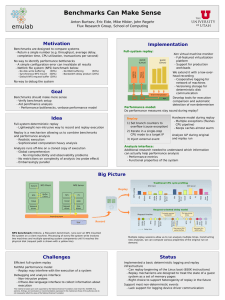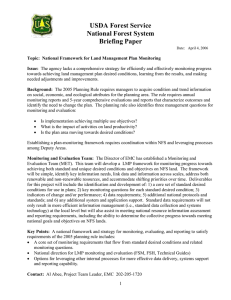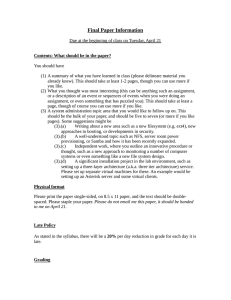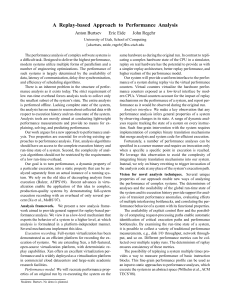emulab A Replay-based Approach to Performance Analysis Big Picture
advertisement
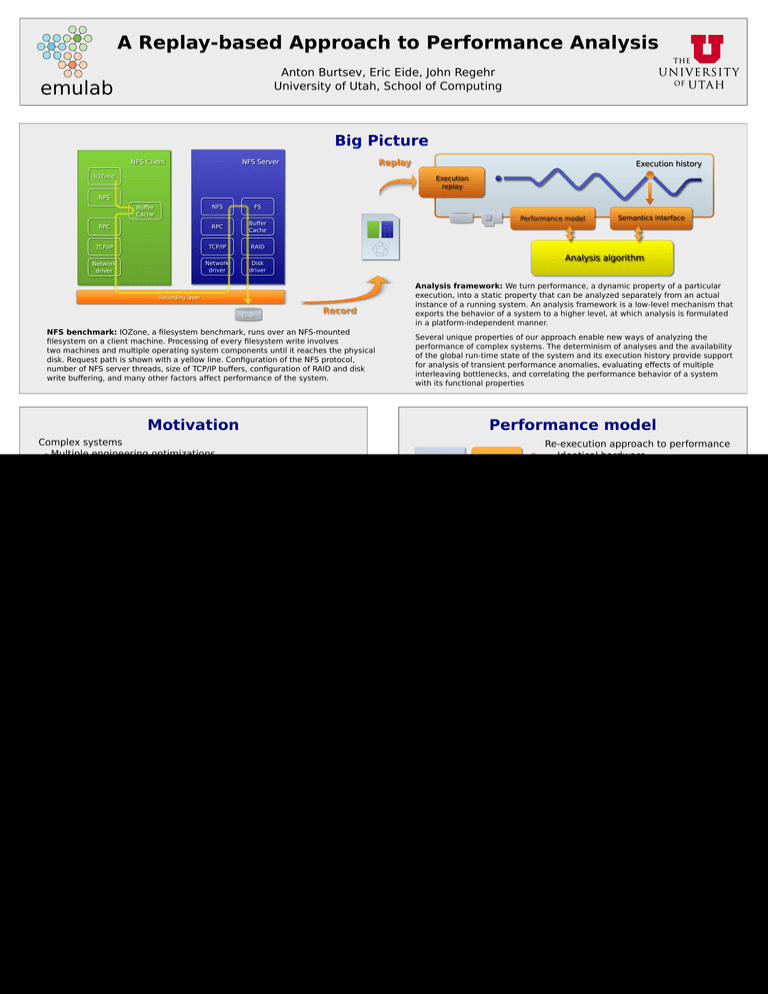
A Replay-based Approach to Performance Analysis
Anton Burtsev, Eric Eide, John Regehr
University of Utah, School of Computing
emulab
Big Picture
Analysis framework: We turn performance, a dynamic property of a particular
execution, into a static property that can be analyzed separately from an actual
instance of a running system. An analysis framework is a low-level mechanism that
exports the behavior of a system to a higher level, at which analysis is formulated
in a platform-independent manner.
NFS benchmark: IOZone, a filesystem benchmark, runs over an NFS-mounted
filesystem on a client machine. Processing of every filesystem write involves
two machines and multiple operating system components until it reaches the physical
disk. Request path is shown with a yellow line. Configuration of the NFS protocol,
number of NFS server threads, size of TCP/IP buffers, configuration of RAID and disk
write buffering, and many other factors affect performance of the system.
Several unique properties of our approach enable new ways of analyzing the
performance of complex systems. The determinism of analyses and the availability
of the global run-time state of the system and its execution history provide support
for analysis of transient performance anomalies, evaluating effects of multiple
interleaving bottlenecks, and correlating the performance behavior of a system
with its functional properties
Motivation
Performance model
Complex systems
- Multiple engineering optimizations
- Composed of simple components that promptly evolve into
complex artifacts
- Emergent behavior
Performance is determined by
- Availability of data
- Latencies of communication
Re-execution approach to performance
- Identical hardware
- Recreate conditions of the original run
Performance counters
- Export performance for analysis
- Simple linear model
- Need to record only time
- Delays of synchronization
- Efficiency of scheduling
Analysis requires reasoning about
- Dynamic state of multiple components, buffers, and caches
- Control and data flow between them
- Performance of individual requests (slow and fast paths)
- Availability of resources for pipelined and parallel execution
Existing approaches are inherently limited
- Strict requirement of low run-time overhead
- Collect only minimal subset of the run-time state
- No means to correlate collected data with actual system's state
Idea
- Capture complete execution with deterministic replay
- Run analysis offline
- An old idea (Balzer, AFIPS'69), which is enabled by recent
advances in virtualization (Xu et al., MoBS'07)
Virtual performance counters: account for effects of replay mechanisms,
and translate performance between original and replay runs.
Analysis interface
Analysis is driven by changes in run-time state of the system
- "Big step" semantics
Binary rewriting to instrument execution (SystemTap)
- Safe analysis language
probe kernel.function(*@mm/*.c).call
{ called[probefunc()] <<< 1 }
We integrate it with deterministic replay mechanisms
Insight into analysis algorithms
Traditional CPU cycle profiling
RAID
Disk
Driver
Disk
Driver
Disk
FS
TCP/IP
Network
Driver
idle
Network
Driver
TCP/IP
Buffer
Cache
IOZone
idle
NFS
Processing time
Dynamic load of
socket buffers
RAID
FS
NFS
Per-packet delay
TCP/IP
Network
Driver
Network
Driver
TCP/IP
NFS
- Low-overhead recording
- Analysis of the entire software stack
Compute average
bandwidth
Request timeline
Buffer
Cache
Combine recording mechanisms with a full-featured VMM
Critical path analysis
IOZone
Goal:
- Realistic systems
- Realistic workloads
CPU cycles
Execution replay
NFS
NFS Server
NFS Client
Dynamic load of
the RAID buffer
Multiple replay sessions allow us to run different analyses and
collect various performance measurements in a consistent way.
Logging and replay infrastructure: four logging and replay components and
a high-bandwidth communication channel across them are designed to implement
lightweight recording of all nondeterministic events.
- Automatic generation of the
request-processing path
- Fine-grain performance
model
This material is based upon work supported by the National Science Foundation under Grants No. 0524096, 0709427.
Any opinions, findings, and conclusions or recommendations expressed in this material are those of the author(s) and do
not necessarily reflect the views of the National Science Foundation
- Automatic search for transient
performance anomalies
- Combination with static
analysis
